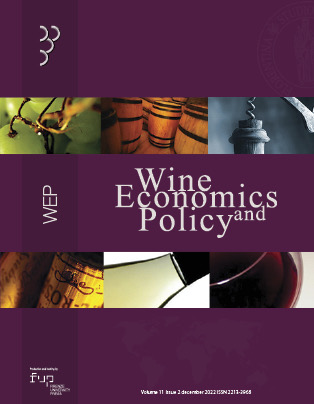Published 2022-10-25
Keywords
- common agricultural policy,
- de-alcoholised wine,
- hybrid grape varieties,
- labelling
How to Cite
Abstract
On January 1, 2023, a “reformed” Common Agricultural Policy (CAP) will come into force, which is innovative by nature in structural terms, and focused on environmental and social sustainability issues, aimed at a comprehensive digitization-based modernization of the agri-food sector. The new CAP keeps the current structure based on expenditure and regulatory measures, but includes a new planning tool, the national CAP Strategic Plan, a new CAP management model, and the new delivery model (NDM). Concerning EU wine policy, the new regulations foresee a number of specific amendments to existing rules, including changes that will apply to financial support for the wine sector with a reduced budget and to the regulatory measures. Among the latter, the most globally impacting are labelling rules, which require more information to consumers and allow the use of an e-label, the use of hybrid grape varieties for the production of appellation wines, and the inclusion among CAP regulated products of partially or totally de-alcoholised wines.
References
2 Meloni G, Swinnen J (2013) The political economy of European wine regulations. Journal of Wine Economics 8(3):244–284
3 Gaeta D, Corsinovi P (2014) Economics, governance, and politics in the wine market: European union developments. Palgrave Macmillan, London and New York
4 Anderson K, Jensen HG (2016) How much government assistance do European wine producers receive? Journal of Wine Economics 11(2):289–305
5 Erjavec E. (2018) CAP strategic planning: scope and implications. Post, CAP Reform, June 21:2018
6 European Commission (2018) Proposal for a Regulation of the European Parliament and of the Council establishing rules on support for strategic plans to be drawn up by Member States under the Common agricultural policy (CAP Strategic Plans) and financed by the European Agricultural Guarantee Fund (EAGF) and by the European Agricultural Fund for Rural Development (EAFRD) and repealing Regulation (EU) No 1305/2013 of the European Parliament and of the Council and Regulation (EU) No 1307/2013 of the European Parliament and of the Council, COM(2018) 392 final, Brussels, 1.6.2018 https://eur-lex.europa.eu/resource.html?uri=cellar:aa85fa9a-65a0-11e8-ab9c-01aa75ed71a1.0003.02/DOC_1&format=PDF
7 Agrosynergie GEIE (2018) Evaluation of the CAP measures applicable to wine. European Union, Luxemburg https://ec.europa.eu/agriculture/evaluation/market-and-income-reports/cap-measures-wine-sector_en.
8 Pomarici E., Di Chiara V. (2022) Scelte conservative nei Piani strategici della Pac, Vite&Vino, n. 3.
9 Henke R., Pupo D’Andrea M.R., Benos T., Castellotti T., Pierangeli F., Romeo Lironcurti S., De Filippis F., Giua M., Rosatelli L., Resl T., Heinschink K. (2015), Implementation of the First Pillar of the CAP 2014-2020 in the EU Member States, Study for the European Parliament, Directorate General for Internal Policies, IP/B/AGRI/IC/2014_45. Volume PDF 978-92-823-7646-1 Carta 978-92-823-7645-4 Annex PDF 978-92-823-7961-5 Carta 978-92-823-7962-2
10 Pomarici E, Vecchio R. Will sustainability shape the future wine market? Wine Econ Policy. 2019; 8(1): 1–4.
11 Montaigne E, Coelho A, Khefifi L. Economic issues and perspectives on innovation in new resistant grapevine varieties in France. Wine Econ Policy. 2016; 5(2): 73–77.
12 Casanova-Gasco´n J, Ferrer-Martı´n C, Bernad-Eustaquio A, Elbaile-Mur A, Ayuso-Rodrı´guez JM, Torres-Sa´nchez S, et al. Behavior of vine varieties resistant to fungal diseases in the Somontano region. Agronomy. 2019; 9(11): 738.
13 Salmon JM, Ojeda H, Hubert A, Giraud He´raud E, Fuentes Espinoza A, De Herralde F, et al. Livre blanc sur les varie´te´s re´sistantes: e´ tat des lieux en France, Espagne et Portugal, Projet SudOe Vinovert, Editor Vinovert. 2018. Available from: https://vinovert.eu/images/publications/L111_LIVRE_BLANC_3lgues.pdf.
14 Vecchio, R., Pomarici, E., Giampietri, E., Borrello, M. (2022). Consumer acceptance of fungus-resistant grape wines: Evidence from Italy, the UK, and the USA. PLoS ONE, 17(4 April)
15 Moio L. (2018) Vers une logique de l’etiquetage du vin, Conference at the Bordeaux U
16 Stasi, A., Bimbo, F., Viscecchia, R., Seccia, A. (2014) Italian consumers' preferences regarding dealcoholized wine, information and price, Wine Economics and Policy, 3(1), pp. 54–61
17 Meillon, S., Dugas, V., Urbano, C. and Schlich, P. (2010), “Preference and acceptability ofpartially dealcoholized white and red by consumers and professionals”, American Journalof Enology and Viticulture, Vol. 61 No. 1, pp. 42-52
18 Masson, J., & Aurier, P. (2017). Modifying wine alcohol content: sensory and non-sensory impacts on quantities consumed. International Journal of Entrepreneurship and Small Business, 32(1-2), 102-117.
19 Margallo, M., Aldaco, R., Barceló, A., Diban, N., Ortiz, I., & Irabien, A. (2015). Life cycle assessment of technologies for partial dealcoholisation of wines. Sustainable Production and Consumption, 2, 29-39.
20 Pertot I, Caffi T., Rossi V., Mugnai L., Hoffmann C., et al. (2017) A critical review of plant protection tools for reducing pesticide use on grapevine and new perspectives for the implementation of IPM in viticulture. Crop Protection, Elsevier, 2017, 97, pp.70-84. 10.1016/j.cropro.2016.11.025. hal- 02628891
21 Dal Bianco A., Boatto V., Caracciolo F., Santeramo F. G. (2016). Tariffs and non-tariff frictions in the world wine trade, European Review of Agricultural Economics, Volume 43, Issue 1, February 2016, Pages 31–57, https://doi.org/10.1093/erae/jbv008
22 Mariani, A., Pomarici, E. (2019) Barriers to Wine trade, The Palgrave Handbook of Wine Industry Economics, pp. 291–315

